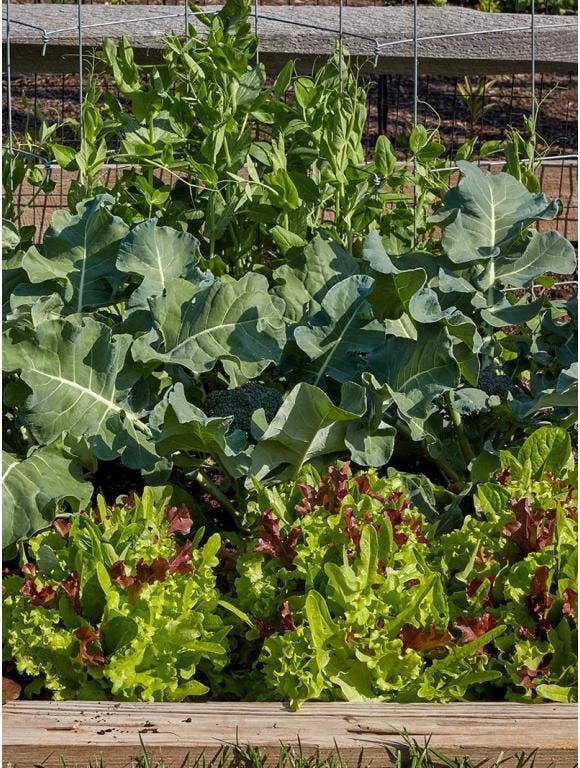


Most vegetables prefer full sunlight — six or more hours each day. Trouble is, vegetable gardens tend to end up in backyards, where trees, structures and other sun blockers can limit sunny exposures. To maximize your available space, it's helpful to know what vegetables can be planted together. A ready-made solution is companion planting, which has potential benefits that go well beyond saving space.
Companion planting is a botanical buddy system of sorts. It's intended to not only make the best use of all available space but to also put plants in the most favorable conditions possible. That includes choosing which "friends" to pair them with and which "enemies" to keep their distance from. When done correctly, companion planting can boost productivity and help fend off disease and pest damage in the garden.
Here's how to decide which vegetables to plant together and planting strategies that can benefit your garden.
Factors That Affect How Well Plants Grow Together
Consider the following factors when planning which vegetables to plant together:
Mature Size
While they might start small, be aware of a plant's mature size before planting. Otherwise, a plant can take over more space than you were anticipating and crowd others out. The seed packet can give you the information you need for planting. It tells you how far apart to sow seeds, and it recommends how to thin out small seedlings once they've sprouted so the remaining plants have enough space to mature. If you're working with garden-ready plants instead of seeds, a plant tag will provide recommended spacing to help you decide what vegetables can be planted together.
Growth Patterns
Some plants stand upright, like corn; others climb, like pole beans; and still others sprawl, like squash. Native Americans put all three together to maximize space and reap other rewards. The beans grew up the cornstalks, making use of vertical growing space, while the squash vines utilized horizontal growing space by sprawling on the ground. The large squash leaves shaded out weeds and kept the soil from baking and cracking. Once bean plants died, their roots disintegrated and replenished the soil nitrogen the corn had used. When mixing plants, a general rule of thumb is to pair plants that have different habits or growth patterns. One example is to pair garlic, which grows mainly belowground as a bulb, with spinach, which grows primarily aboveground as a foliage plant.
Growth Rate
Putting slow- and fast-growing plants together can work as long as the fast-growing partner doesn't crowd out its companion. One example is radishes, which are the jackrabbits of the vegetable world. Radishes mature in as little as 30 days. Carrots, on the other hand, can take 70 to 80 days to mature. You can use the fluctuating growth rates to your advantage by sowing radish and carrot seeds together. Once you harvest the radishes, the carrots have more room to grow.
Growing Season
Most vegetables come in one of two categories: cool season or warm season. One aspect of companion planting is to follow up a cool season crop with a warm season crop. For example, once cool season peas are done, there's room for warm season beans to grow. There can be some overlap: Small pepper plants can be planted in a bed of leaf lettuce in late spring. By the heat of summer, the lettuce is ready to bolt, or go to seed, so it can be pulled, allowing the pepper plants to take over.
Vegetables That Grow Well Together
While some plants grow well together, others, like carrots and dill, do not. Some plants exude a chemical that inhibits the growth of nearby plants; others may attract more pests. On the other hand, highly fragrant plants, such as sage or rosemary, may distract insect or animal pests away from more valuable plants. Garden vegetables that grow well together include:
- Basil and tomatoes
- Radishes and lettuce
- Peas and carrots
- Pumpkins or squash and corn
- Beets and onions
- Potatoes and eggplants
Planting Strategies
In nature, monocultures are rare (aside from the occasional aspen grove!). Instead, a variety of plants coexist together, making it tougher for pests to locate target plants and slowing the spread of disease. Companion planting picks up on that strategy. Planting marigolds throughout a vegetable garden, for example, can stop soil nematodes from harming tomato plants. And clover can distract rabbits from feasting wholeheartedly on your vegetables while also boosting nitrogen in the soil. If you're row planting, intersperse companion plants in each row or place them in adjacent rows. Another idea is to plant in self-contained pockets or "neighborhoods," surrounding one type of plant with another.
Mixing Ornamentals and Edible Plants
One trend to watch is the practice of interplanting edible plants and ornamentals. One reason it's gained popularity is that it allows you to start planting produce in your front yard. Even if zoning ordinances or homeowner association rules prohibit front-yard vegetable gardens, it's unlikely they'll prevent you from growing Swiss chard and kale among your flowers or chives with your rosebushes. Purple leaf lettuce varieties make nice edging plants, while a fair amount of herbs look right at home in a rock garden.
By combining vegetables that grow well together, you can optimize your garden and make the most out of your space.
For more information on companion planting and plants that grow well together, check out Burpee's companion planting guide.



